Decorative Designs in Chinese Art 中国文物的纹饰
Wood 木料 Furniture 家具
Click on any word to see more details.
Furniture 家具
Ancient Chinese people sat on mats on the floor 席地而坐, according to an old saying. The earliest furniture was made with reeds and bamboo and was short to be in keeping with this mode of resting. It was only later in the Tang that people sat with legs hanging down 垂足而坐 on higher seats. The styles now thought of as classical Chinese emerged in the Tang, including beds, tables, seats, closets, and clothes racks. Every effort was made to add decorative patterns and fine carvings, giving the artifacts distinctively Chinese characteristics. The three main styles of classical Chinese furniture are Suzhou style 苏式, Guangzhou style 广式, and Beijing style 京式, in addition to some other regional styles.
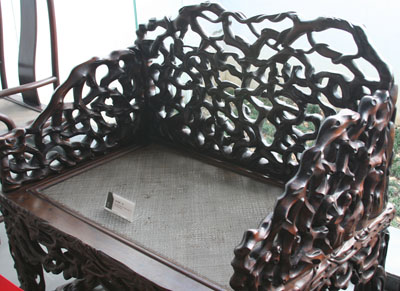
The gardens of Suzhou are beautiful and some of the best places to see classical Chinese furniture. Perhaps the best known is the Humble Administrator's Garden 拙政园. In the Ming and Qing there were over two hundred gardens in Suzhou. Four have now been listed as part of the Suzhou Gardens UNESCO World Heritage Site. These gardens had a big influence on the styles of furniture produced in Suzhou.
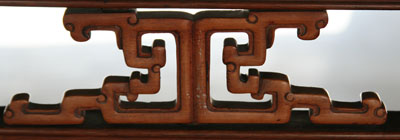
Yellow rosewood was the first choice of timber for furniture because of its hardness, color, and grain. Other preferred varieties of wood for furniture were red sandalwood and mahogany, followed by beech. Furniture made from softer wood has not survived. Table shown above and many of the others on this parge are rosewood.
Rectangular spiral patterns 回纹 as used on the table below are one of the most commonly used patterns in Qing furniture.
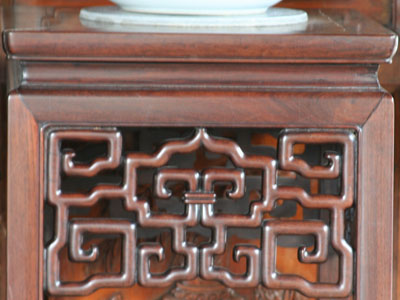
The Jiangsu area and nearby was an early center of furniture production in the Ming, especially Suzhou, Yangzhou, and Songjiang. In particular, Suzhou, was an economic center at this time, with manufacturing of woven silk, embroidery, printing, lacquer ware, and furniture. Furniture was produced for the Imperial Court, regional government, and for private residences.
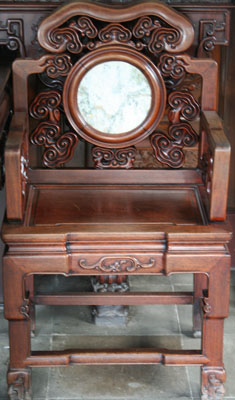
Suzhou style furniture is simple and elegant. Furniture was often made out of a single piece of wood, which allowed the furniture to have smooth and flowing lines.

Mahogany 红木 began to be used in Suzhou style in the Qing. The picture below shows the detail of a mahogany chessboard.
The chairs in the table set below from the Hall of Distant Fragrance 远香堂 are interesting that they are immitating a popular bamboo design in a more expensive type of wood (mahogany). The dragon design on the rim of the table can be seen on the detail to the right. Stools 凳子 are a characteristic item of Chinese furniture. Even in the very elegant table set above, stools are used by choice instead of chairs.
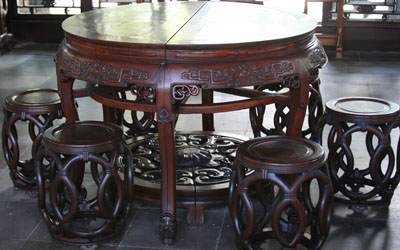
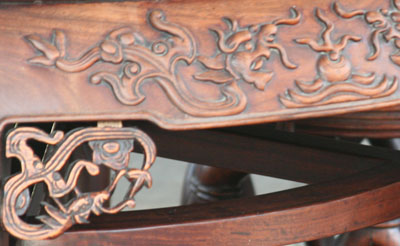
The circle is considered considered to be the origin or all creation. The ring is used as a symbol of eternity.
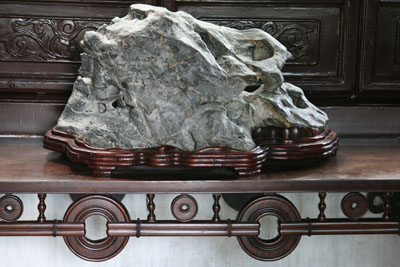
Fujian and Zhejiang were the two areas best known for wood carving in the Ming and Qing. Even when used in palaces and the estates of high ranking officials, wood carving has a folk flavor to it. Designs usually fit into one of three categories: (1) auspcious patterns 吉祥图案, such as cranes under a pine tree 松鹤延年; (2) figures in Chinese operas, traditional stories, and so on; (3) popular customers, such as weaving, grazing, entertaining, and so on.
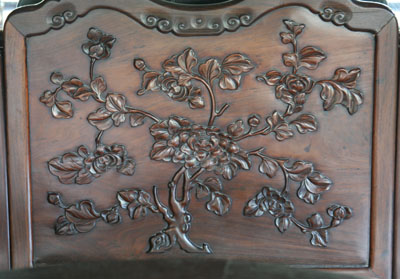
The mirror stand below has a pattern that immitates a design made with vines.

Next to the Suzhou Museum is the Taiping Heavenly Kingdom 太平天国 Prince Zhong Mansion 忠王府. This was the residence of Liu Xiucheng 李秀成 (1823—1864) military leader of the Taiping Rebellion. The throne-like chair below is a replica of the one used by Liu Xiucheng.
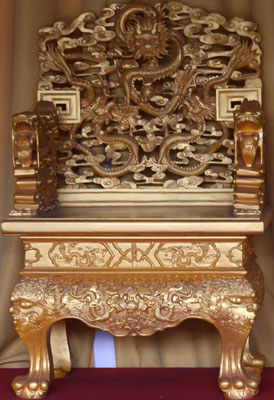
Suzhou style furniture began to be eclipsed by Guangzhou style during the Qing. The focus of the articles produced changed from the imperial court and homes of high officials to more popular use.
Dictionary cache status: not loaded
Chinese
Pinyin English